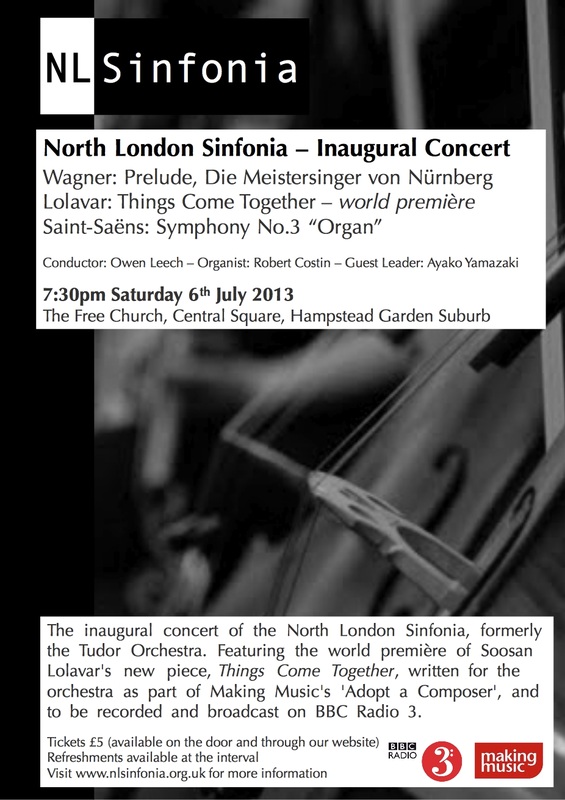Adopt a Composer
We were delighted to be paired with Soosan Lolavar in the Adopt a Composer 2012/2013 Scheme which is run by Making Music and funded by the PRS for Music Foundation. Soosan produced a new piece of music, Things Come Together, performed at the NLS Inaugural Concert on Saturday 6th July 2013 and recorded for BBC Radio 3. Check out Soosan's Blog, and see below what our own members made of the experience.
"Things Come Together" was featured on BBC Radio 3 on 14th January 2014, along with interviews with Soosan and members of NLS - click here to listen to the recording, or here to see the film produced by Soosan featuring the piece.
‘I thought she was going to go off and write something,’ one of the orchestra members said to me a few weeks before this, our first ‘devising’ day. Perhaps the Adopt a Composer scheme should come with a warning: participating may change your ideas about music and playing in an orchestra (but it is worth it). It had been really nice to get to know Soosan, but now we had to start working.
There were fifteen of us in the end, who had battled the snow, overcome the engineering works on the Northern Line, and the naked feeling of going to a rehearsal without any sheet music, or a last panicky look at a really difficult passage.
After introductions we took out our instruments and started experimenting. Soosan would give us only a few notes at the time, with little exercises: to join in what someone else had started, to rearrange chords, to create a melody in a very democratic way - each contributing one note at the time.
I am not sure what to think of what was created in those exercises. I really liked some parts and was less certain about others. Our piece felt strangely unbalanced - and yet there was structure in the repetition of rhythms, and notes. On reflection, that judgment seems to me one of the very valuable elements from this day. As a member of the orchestra you may think yourself, to paraphrase Plato, twice removed from reality: a composer has given you notes and a conductor will tell you how to play them. This is no longer true. In well devised exercises, Soosan had - to continue the platonic metaphor - led us out of the cave. I feel slightly dazed and confused, but also keen to do more of this.
And if you hear a well-placed c-sharp, held on for two beats, please note: that was my contribution.
Marije Altorf (viola)
There were fifteen of us in the end, who had battled the snow, overcome the engineering works on the Northern Line, and the naked feeling of going to a rehearsal without any sheet music, or a last panicky look at a really difficult passage.
After introductions we took out our instruments and started experimenting. Soosan would give us only a few notes at the time, with little exercises: to join in what someone else had started, to rearrange chords, to create a melody in a very democratic way - each contributing one note at the time.
I am not sure what to think of what was created in those exercises. I really liked some parts and was less certain about others. Our piece felt strangely unbalanced - and yet there was structure in the repetition of rhythms, and notes. On reflection, that judgment seems to me one of the very valuable elements from this day. As a member of the orchestra you may think yourself, to paraphrase Plato, twice removed from reality: a composer has given you notes and a conductor will tell you how to play them. This is no longer true. In well devised exercises, Soosan had - to continue the platonic metaphor - led us out of the cave. I feel slightly dazed and confused, but also keen to do more of this.
And if you hear a well-placed c-sharp, held on for two beats, please note: that was my contribution.
Marije Altorf (viola)


